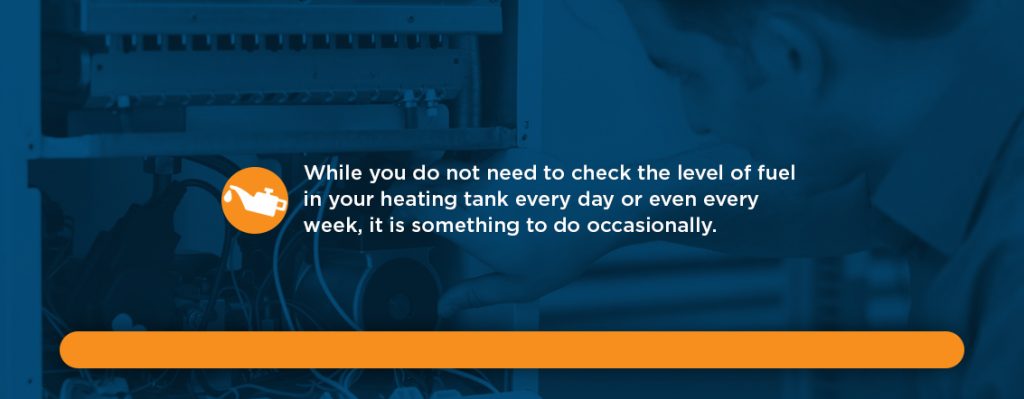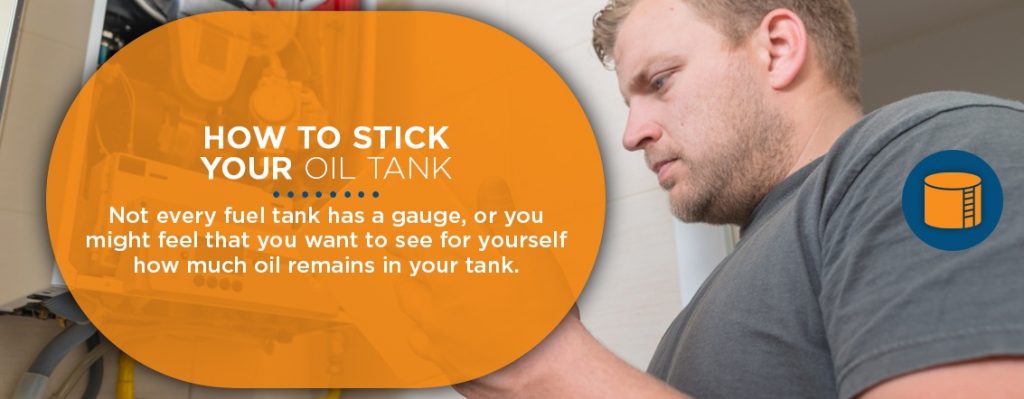How to Find Out How Much Oil Is Left in Your Tank
You would not want to run out of fuel while driving across the country on a road trip or even if you were just driving across town during your commute. The same is true of the fuel you use to heat your home. You want to make sure there is an adequate amount of heating oil in your home’s tank at all times so that your home can remain comfortable when you need to use your heating system. Knowing how to check the oil in your tank, the shelf-life of heating oil and what to do if you need more oil will help you protect your system and keep your home warm and cozy.
Learn more about how to measure the amount of oil in your tank, how to read an oil tank gauge and how to use less fuel so that your heating oil lasts longer.
Why Manually Check Your Oil Level?
There are several reasons why it is a good idea to manually check the level of oil in your heating tank. If you have your oil deliveries set up on a will-call basis, it is up to you to keep an eye on the level and to call your fuel provider when your supply is low. Keeping an eye on the level of oil in your tank is also a good idea even if you are signed up for scheduled delivery. An unexpected cold spell could cause your heating system to use more fuel than expected, meaning you run the risk of running low before your next delivery. Additionally, an issue with your heating system can mean it starts to use more fuel than normal.
If you’re signed up for automatic delivery, it is still worthwhile to check your fuel oil levels from time to time. It might be that your home uses more oil than originally anticipated so that you need more deliveries than expected. Things like long-term visitors, a new baby, or even being home more often than usual may cause you to use more oil than usual. If you’re on automatic delivery, it’s always a good idea to alert your oil company of any changes like this so they can adjust the formula used to determine when you should receive your next delivery.
Finally, monitoring the level of oil in your fuel tank can help you avoid running out of fuel. When you run out of oil, there is a chance that your heating system will be damaged. Sediment and debris can get pulled from the tank into the lines, increasing the risk of clogs. Your heating system will also power down when there is no more fuel to run it, which can leave you feeling the chill on a wintery night. Checking the level in your oil tank allows you to call for delivery before the tank runs dry.
When Should You Check Your Heating Oil?

While you do not need to check the level of fuel in your heating tank every day or even every week, it is something to do occasionally. There are certain times of the year and certain circumstances during which it makes sense to check on the level of fuel. For example, it is worthwhile to measure the fuel in your tank just before the heating season begins, usually around the beginning of October. That way, you can see how much oil might be leftover from last season and get a sense of how much oil you will need during your next fill-up.
It is also a good idea to check on your oil tank after a period of unusually cold weather. If your area sees a cold snap in October or late March, you might burn more oil than you usually do during that time, causing your tank to become depleted more quickly.
You also want to take a peek at your heating oil level if your heating system suddenly shuts down. Although there are other reasons for a furnace or boiler to power down, being out of fuel is a common one.
Extra tip: It’s also a good idea to check your tank at the end of the winter season, and to make sure you have a full tank before summer. An empty or low oil tank can cause condensation on the inside of your tank, which can cause it to rust from the inside. Keeping your tank full will prevent this damage to the inside of your tank. Prices also tend to be slightly lower when the weather starts to get warmer!
How to Check Your Heating Oil Level
There are generally two ways to check the level of oil in your tank. You can read the gauge on the tank or physically measure the amount of oil in the tank. Reading an oil tank’s gauge is the less involved option, but not every tank has a gauge, so you might need to “stick” the tank using an oil tank measuring stick, or dipstick.
How to Read an Oil Tank Gauge
Depending on the type of gauge on your tank, reading it is very similar to reading the fuel gauge in your car or reading a thermometer. Some gauges are in the shape of a tube. They have a small piece of plastic inside, known as a float. The float rises and falls up and down in the tube based on the amount of fuel in the tank. When the float is near the top of the tube, the tank is fully or nearly full. When the float is near the bottom of the tube, the tank is approaching empty.
Another style of fuel gauge uses a small lever to tell you how much is in the tank. Similar to the gas gauge in your car, the lever moves based on the amount of fuel in the tank. When it’s pointing straight up and down, the tank is about half-full. If it’s leaning all the way to the right, the tank is full. If the gauge is all the way to the left, the tank is empty.
How to Stick Your Oil Tank

Not every fuel tank has a gauge, or you might feel that you want to see for yourself how much oil remains in your tank. You can physically measure the depth of oil in tanks that have a vertical fill pipe by “sticking” the tank. If you have ever used a dipstick to measure the level of oil in your car, then you are familiar with the concept of using a stick to measure the depth of oil in a tank. You can stick your tank whether it is above ground or underground.
To stick your oil tank, you will need a long stick that is at least six feet in length. You do not want the stick to be too short, as you do not want to run the risk of dropping it in the tank and not being able to retrieve it. To measure the oil in your tank, remove the cap from the fill pipe and carefully slide the stick in. Keep going until you reach the bottom of the tank. As you thread the stick into the tank, keep it as straight as possible so that you get an accurate measurement.
Pull the stick out of the tank slowly. Examine the stick, looking at how much of it is wet with oil. The height of the wet mark will give you a good idea of the amount of fuel that remains in your tank, provided you also know the size of your oil tank. You can use a heating oil tank measurement chart to convert inches to gallons in your fuel tank. For example, if you stick a 275-gallon vertical tank and the wet mark is nine inches tall, there is most likely about 43 gallons remaining in the tank.
How Long Should Heating Oil Last?
If you have oil remaining in your tank from last season, you might wonder if it is still safe to use or if it is past its prime. For the most part, heating oil has a relatively long shelf-life. The fall and winter in Southern Maryland get cold enough that it is likely you will use all of the oil in your tank before it reaches the end of its shelf-life. Keeping your tank full through the months you do not use heat can help make it last longer by preventing rust particles to form sludge in your tank. Another factor that may make your heating oil unusable after sitting for a long period of time is if water gets into your tank.
If your oil tank hasn’t been used in a long time and you are unsure of the quality of the oil in your tank, one of our drivers or technicians can come to test the quality of the oil in your tank and make a recommendation for you.
How Do You Know If Your Heating Oil Is Bad?
Heating oil should smell like oil. One sign that your heating oil has gone bad or is contaminated with bacteria or fungus is a foul, rotting odor. If you open your oil tank at the end of the summer and notice a strong, strange smell, the oil might be bad.
If you are not sure about the state of the oil in the tank, your best option is to call in a technician to come out and take a look. They will let you know how the oil is doing and what your options are for replacing it or refilling the tank.

What to Do When You've Run out of Heating Oil
One day, your heating system stops working and will not turn back on no matter what you do. You inspect your oil tank and realize that it has run out of fuel. The first thing to do when that happens is not panic. The next thing to do is call SMO Energy to schedule a delivery. We offer same-day and next delivery services* and 24/7 emergency service when you are out of heat.
After you have scheduled your delivery, you want to find a way to keep your home warm while you wait. If you have space heaters, you can set them up and use them in the areas that will be occupied. Just make sure to play it safe with the space heaters. Place them at least several feet away from furniture and textiles and supervise children when they are near the heaters. Remember to switch off the space heaters when you leave the room.
If you have diesel fuel or kerosene on hand or can get to a gas station to purchase some, you can use it as a temporary source of fuel while you wait for your oil delivery. You can add between five and 10 gallons of diesel fuel or kerosene to your oil tank. If possible, it is ideal to add the fuel to the tank before it is completely empty and before the heating system shuts down. If your system has shut down, you might need to wait for a technician to arrive to get it up and running again.
How to Make Your Heating Oil Last Longer
Even when it’s particularly cold outside, there are things you can do to reduce your fuel use and to help the oil in your tank last longer. Turning down your thermostat by one or two degrees will help to reduce the amount of oil your heating system burns, for example. You can make up for the lower indoor temperature by wearing more layers, putting on a pair of thick socks and by wrapping yourself in a blanket or two while you’re lounging about your home.
Servicing your furnace regularly will help it to operate more efficiently so that it uses less fuel and you can go longer between fill-ups. Depending on the condition and age of your furnace or heating system, you might find that replacing it with a newer and more efficient model ends up saving you money and fuel over time.
A few tweaks or hacks in your home can also help you extend the life of your heating fuel. If possible, open the blinds or curtains on the windows in your home to let the sun shine in during the day. Even during the winter, the heat from the sun’s rays can help your home feel warmer, without you needing to crank up the heat. Once the sun has gone down, close the blinds or curtains to provide an extra layer of insulation. Making sure your windows are sealed tight and that any areas where cold air can seep in, such as around outlets or pipes, are closed off, can also help to make your home warmer.
Contact SMO Energy for Oil Delivery and for All Your Home Comfort Needs
Keeping an eye on the amount of heating oil that remains in your home’s tank is not only good for your comfort at home, it is also good for the health of your heating system. Making sure you do not run out of oil allows your system to operate as it should and reduces the risk of damage. SMO Energy offers heating oil delivery to businesses and homes across Southern Maryland. Delivery is available on an automatic, scheduled or will-call basis. Should you run out of oil, we also offer same-day and next-day delivery*, to quickly get your system working again.
Consider SMO Energy your total home comfort provider. Along with delivery, we also offer repair and replacement of heating systems, service agreements and home energy consultations to help you be certain that the equipment you are using is right for your home. Our live client care agents are standing by, ready to answer any questions you have about your oil tank and fuel needs. Contact us today to learn more.
*No delivery fee applies to all deliveries 125 gallons or more, same-day delivery is applicable to a fee. **Same day and next day delivery service are subject to change based on weather conditions. Unsafe road conditions create an unnecessary risk to SMO drivers and the environment.

